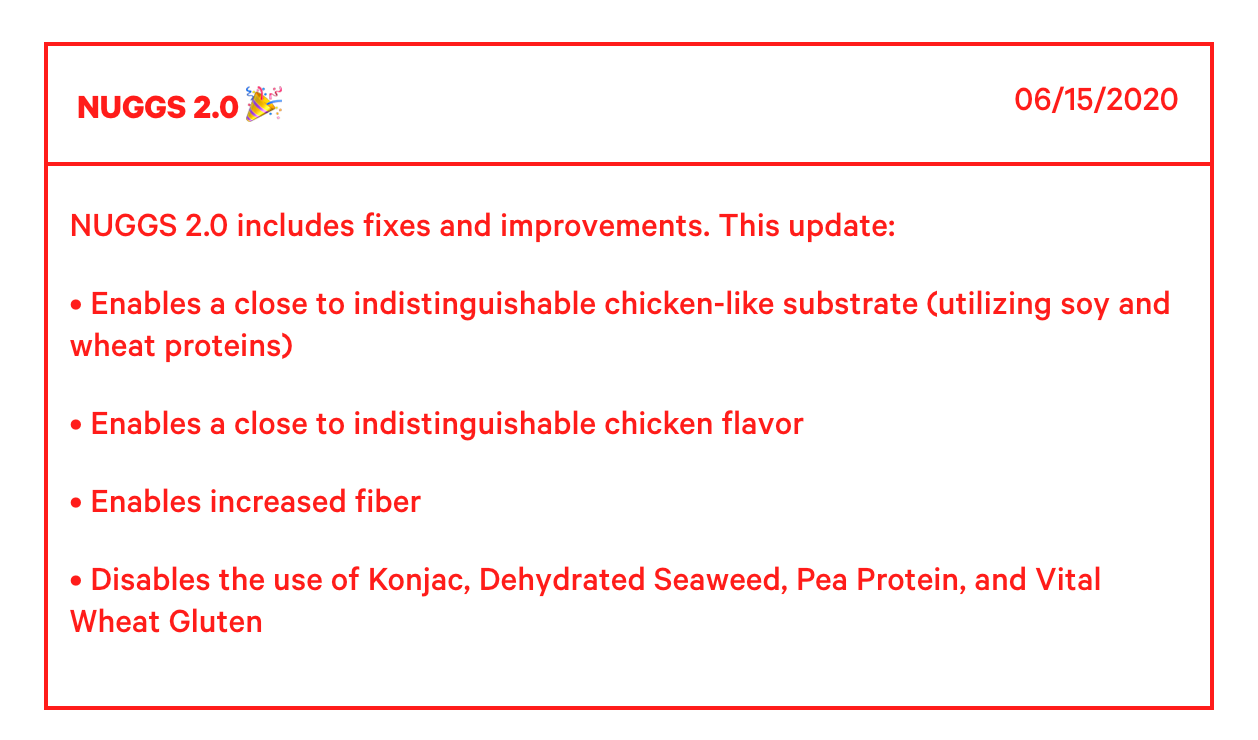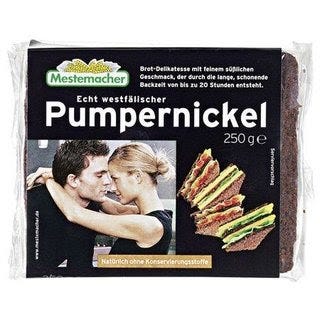Don't Be Chicken
The future of food — version 1.0 and beyond
A newsletter about branding, startups, and mission-driven companies aiming to make the world a better place.
👋 Welcome to For The Love, I’m so happy to have you all here!
Today we’ll be discussing:
The new trend in food? Simulate and iterate
A roundup of new launches this week, including clean skincare from a seemingly ageless multi-hyphenate
Bread made for cuffing season
If you were forwarded this by a friend, join 1,200+ other DTC enthusiasts by subscribing here!
📖 For The Love of Reading with Friends
If you've ever wondered why jingles get stuck in your head, check out The Marketing Mind Meld — an exploration into the intersection between marketing and psychology.
💣 For The Love of Startups
When Andreessen Horowitz backed drinkable food-substitute, Soylent, in 2014, it was billed as “the end of food.”
Thankfully, people still eat food. So it wasn’t quite the revolution they’d hoped for.
When Soylent launched The New York Times called it “the most joyless new technology to hit the world since we first laid eyes on MS-DOS.”
They didn’t stop there.
“For a purported breakthrough with such grand plans for reshaping the food industry, I found Soylent to be a punishingly boring, joyless product. From the plain white packaging to the purposefully bland, barely sweet flavor to the motel-carpet beige hue of the drink itself, everything about Soylent screams function, not fun. It may offer complete nourishment, but only at the expense of the aesthetic and emotional pleasures many of us crave in food.”
A review this bad might have killed off most products, but Soylent’s iterative approach brought them incremental improvements. In fact, they’ve borrowed software nomenclature, calling their most recent product Version 1.9.
While it may not be any less joyless, it does seem like they’ve improved the taste based on customer feedback. It can now be found at 20,000 retail locations across the US.
Soylent kicked off a wave of “efficient” food innovation that felt a lot like the waves of change we see in tech.
While Soylent was born of a passion for personal efficiency, other recent food innovations have come from a desire to reduce the impact our food system has on the environment, using less water and producing less greenhouse gas.
Beyond Meat claims to “improve human health, positively impact climate change, address global resource constraints, and improve animal welfare.”
Impossible Foods argues that “cows, not fossil fuels, are the most destructive technology on earth,” a fact that the EPA seems to disagree with. In 2018 agriculture contributed to 10% of greenhouse gas emissions, following transportation, electricity, and industry. Regardless, farming soy is better for the environment than cattle.
Whether this is actually healthy eating is a real question — Beyond and Impossible Burgers have equal or more saturated fats than lean ground beef and about 4.5 times the sodium, but, unlike beef, they’re cholesterol-free.
Both companies are using vegetable protein science to carry out their missions signaled throughout their branding by way of the color green.
Also, the names “beyond” and “impossible,” underscore technology, and imply their ability to innovate past what was previously thought possible.
Does running a food company as a technology startup work?
Public iteration — the idea that a company admits when a product is unfinished and working towards making itself better, seems to be resonating.
Nuggs is a non-chicken chicken nugget that bills itself as “the Tesla of chicken”.
Tesla doesn’t keep the industry-standard yearly new model schedule. They are constantly collecting performance data, tweaking the technology, and whenever they have a meaningful upgrade, they release a new model.
Leaning into his background as a software developer, Simulate (Nuggs’ parent brand) founder Ben Pasternak makes sure each new iteration (version 2.0 as of July) is released as soon as significant improvements have been made and come with a description of the changes.
How do they know what changes to make?
They ask.
Ben Pasternak explained to me:
“We wanted to be very transparent that the product was always improving, and it was always going to be better and better...When we first released the product, it was very different from what it is now. Most people disliked it. And now, you know, almost everyone likes it, and they really like it. Over the last 14 or 15 months, our community has seen their feedback being implemented, which has just created this really strong community and people that are really passionate about what we're doing.”
For the last iteration, they surveyed customers on 62 variables, using their feedback on texture and flavor to get Nuggs closer and closer to replicating chicken nuggets.
I’ve only tried 2.0, but in my opinion, they’re pretty much there.
What Tesla and Nuggs have proven is that, unlike Soylent’s antiseptic approach, innovation can be fun!
Bright, bold pop-y visuals were described by the company’s art director as “MoMa meets McDonald’s.”
There use tongue-in-cheek copy and visuals, including packaging featuring a chicken being fed a Nugg, and meme references like an appearance by Spongebob’s Plankton presumably trying to steal the Nuggs recipe.
Ben said:
“We wanted to do the opposite of what everyone else is doing — farm to table, less processed, super healthy — whereas the first selling point on our website is that it kills you slower. It's a very refreshing thing to see.”
Is this the healthiest product you can buy?
No, but they aren’t billing it that way.
They’re specifically staying away from the green-hued, virtuous messaging of vegetarian brands of the past, and their commitment to conversing with their audience seems to be paying off.
As of July, they’d sold 25 million nuggets.
Where some companies are making meat out of vegetables, others claim to make it out of air.
Finland’s Solar Foods, “Food out of thin air,” and California’s Air Protein, “the world’s first air-based meat,” push the limits of believability.
Are they really materializing food out of nothing like Picard conjuring up “Earl Grey, hot”?
Not quite.
Air is *part* of the process, but so is actual…stuff.
Elements from the air (carbon dioxide, oxygen, and nitrogen) are combined with water and minerals, and some electricity, to feed microbes. The process results in the creation of protein.
This technology has actually been around since the ‘60s, when NASA discovered microbes could convert exhaled carbon dioxide into food.
What they end up with is protein powder, so not really food in its own right.
So perhaps their technological accomplishments aren’t actually as impressive as their branding prowess.
“Food out of thin air” makes for much better clickbait than “microbes that live off carbon dioxide.”
Their visual branding also makes it seem incredibly innovative. Solar Foods uses bold, authoritative fonts, plenty of white space, pastel gradients, and saturated photos.
It’s DTC goes to the lab.
Air Protein leans into blue, because air, and overlays photographs with a graphic pattern, alluding to molecules and bonds.
Is this actually a viable business?
That remains to be seen.
The process is undeniably better for the environment than the alternatives — nearly half of the world’s habitable land is currently used for agriculture, and this protein powder is made in a plant.
That doesn’t mean it can be scaled to become a viable substitute. Solar Foods is currently producing 1kg per day in their plant, which, for reference, CEO Pasi Vainikka says will feed 7-10 people a day’s worth of protein.
It also still needs to become food we want to eat. If past launches of innovative food powders are any indicator, they’d probably do well to consider it version 0.5.
🔥 For The Love of Newness
Real-life Benjamin Button, Pharrell Williams is launching a line of skincare.
The Verticale Marketplace launched your one-stop-shop for mission-driven brands.
Fly by Jing, a line of “Uncensored Chinese Flavors” (aka sauces) got a makeover, and merch to match.
Paume is a new line of better for your skin hand sanitizer.
🔍 For The Love of the Details
Nothing says romance and intimacy like... Pumpernickel?!
I would have thought the sexiest loaf would be French bread, no?
Either way, I think the message here is, “Find some bread that makes you look at your partner the way Oprah looks at double toasted multigrain.”
Thank you for being part of For The Love!
A few more things...
Is there a topic you think I should cover? Or a funny ad I can dissect? I’d love to hear from you! You can email me at info@ajasinger.com, respond to this email, or drop it in the comments ⬇
Know someone who’d enjoy this newsletter?
Was this newsletter forwarded to you?
Written by Aja Singer, a brand and creative strategy consultant interested in all things startup, mission-driven, and community. Born in Canada. Based in Brooklyn. You can also find me on Instagram and Twitter.







Truly interesting article Aja! One thing though... it didn’t make me hungry!